Merionethshire: Difference between revisions
m moved Merioneth to Merionethshire over redirect: HCS standard name |
mNo edit summary |
||
| (20 intermediate revisions by 4 users not shown) | |||
| Line 1: | Line 1: | ||
{{Infobox county | {{Infobox county | ||
|name= | |name=Merionethshire | ||
|welsh=Meirionnydd | |welsh=Meirionnydd | ||
|map image= | |map image=Merionethshire Brit Isles Sect 6.svg | ||
| | |motto=Tra môr, tra Meirion<br />(While the sea lasts, so shall Merioneth) | ||
|picture | |picture=View from Aran Fawddwy - geograph.org.uk - 1505789.jpg | ||
| | |picture caption=View from Aran Fawddwy | ||
|county town=[[Harlech]] or [[Bala]] | |county town=[[Harlech]] or [[Bala]] | ||
}} | }} | ||
The '''County of Merioneth''' is a triangular [[Counties of the United Kingdom|shire]] reaching from the coast on [[Cardigan Bay]] high into the mountains. | |||
Merionethshire is one of the strongest Welsh-speaking parts of Wales. With a total area of 780 square miles and a population of {{#number_format:{{database|Merionethshire|population}}|0||,}}, Merioneth is one of the more sparsely-populated counties in [[Great Britain]]. | |||
== | The county is a shire of mountain and coast; the coastland is perhaps best known to visitors, but the heartland in the mountains is a place of rough beauty. Merionethshire appears split in two by the mountains; Bala in the east is far from the Victorian towns of the coast, but a [[Roman road]] ran over the mountain from [[Bala]] to [[Dolgellau]], a route now traced through the valley by the A494. | ||
Merionethshire is a | |||
The main industries of Merionethshire today are agriculture, forestry and tourism. | |||
==The lie of the land== | |||
[[File:Cader Idris glimpsed from Heulwen.jpg|left|thumb|200px|Cadair Idris]] | |||
Merionethshire is a county on the sea coast and of the mountains. It lies between [[Caernarfonshire]] and [[Denbighshire]] both to the north and [[Montgomeryshire]] to the south. Much of Merionethshire is in the mountains reaching in from [[Snowdonia]], a land of rough mountainous terrain. The county's two rival county towns lie either side of the Snowdonia massif; [[Bala]] in the east at the head of [[Lake Bala]], and [[Harlech]] on the coast in the west. | |||
To the west the shire is washed by the gulf of the [[Irish Sea]] known as [[Cardigan Bay]]. The county's coast runs from the great inlet of the [[River Glaslyn]] estuary, south to the estuary of the [[River Dovey]]. Between the two is a third deep-cut sealoch, the [[Mawddach]] opening into [[Barmouth]] Bay. | |||
The shire is bounded to the north by [[Caernarfonshire]], to the east by [[Denbighshire]], to the south by [[Montgomeryshire]] and [[Cardiganshire]]. | |||
One of the more sparsely populated counties in the [[United Kingdom]], Merioneth remains one of the strongest Welsh-speaking parts of Wales. The coastline consists alternately of cliffs and stretches of sand and the area generally is the most mountainous in Wales. A large part of the Snowdonia National Park lies within Merionethshire. The greatest heights are: | |||
*[[Aran Fawddwy]] (2,970 feet) | |||
*[[Cadair Idris]] (2,929 feet). | |||
The chief rivers of the county are the [[River Dwyryd|Dwyryd]], the [[River Mawddach|Mawddach]] and the [[River Dovey|Dovey]]. Waterfalls and small lakes are numerous, the largest lake being [[Bala Lake]] which is four miles long and a mile broad. | |||
==History== | |||
[[File:North Wales Mawddach.jpg|right|thumb|250px|The Mawddach]] | |||
Merionethshire's name, in legend and possibly in fact, is from Meirion, a grandson of the mighty chief Cunedda who ruled this corner of Britain in late Roman or sub-Roman times. | |||
The county was formed in 1284 under the terms of the Statute of Rhuddlan from the ''Cantrefi'' of: | |||
*Meirionnydd | |||
*Dunoding (but only the larger Ardudwy ''commote'') | |||
*Penllyn | |||
*The Lordship of Dinmael | |||
[[Harlech]] castle was built by King Edward I as part of his "Iron Ring" around the [[Snowdonia|Forest of Snowdon]] and stands proud, if abandoned on the hill. Between 1404 and 1409 Owain Glyndŵr held the castle and ruled his territory from here. The county played its part too in the Wars of the Roses; Harlech again endured a seven-year siege of the castle between 1461 and 1468, when Dafydd ap Ieuan staunchly resisted the Yorkists; an action memorialised in the famous song "Men of Harlech". | |||
Merioneth was an important part of the Welsh slate industry in the nineteenth and twentieth centuries, with major quarrying centres at [[Blaenau Ffestiniog]] in the north of the county and [[Corris]] in the south. The railways came in the nineteenth century and brought work, workers and new town-building. The trains also brought holiday-makers, who made [[Barmouth]] a popular seaside resort and [[Bala]] a place for those seeking the vigorous, fresh mountain air. | |||
Some of the railways remain. The slate-bearing line from [[Blaenau Ffestiniog]] is now a popular tourist attraction, as is the half-mile bridge across the Mawddach to Barmouth. Bala is cut off from the railway network, but a narrow-gauge line runs along the lake. | |||
==Main Towns== | |||
[[File:Barmouth Bridge from Bryn Seward - geograph.org.uk - 217068.jpg |right|thumb|200px|Barmouth across the Mawddach]] | |||
[[File:Dolgellau Rooftops 02.jpg|right|thumb|200px|Dolgellau]] | |||
===Towns and villages=== | |||
The main towns of Merioneth are: | |||
*[[Dolgellau]] | *[[Dolgellau]] | ||
*[[Aberdovey]] | |||
*[[Bala]] | *[[Bala]] | ||
*[[ | *[[Barmouth]] | ||
*[[Blaenau Ffestiniog]] | *[[Blaenau Ffestiniog]] | ||
*[[ | *[[Corwen]] | ||
*[[Ffestiniog]] | |||
*[[Harlech]] | *[[Harlech]] | ||
*[[Tywyn]] | |||
==Parishes== | ===Parishes=== | ||
{{parishliststart}} | |||
*[[Aberdovey]] | *[[Aberdovey]] | ||
*[[Bala]] | *[[Bala]] | ||
| Line 46: | Line 86: | ||
*[[Llanegryn]] | *[[Llanegryn]] | ||
*[[Llanelltyd]] | *[[Llanelltyd]] | ||
*[[Llanfair]] | *[[Llanfair, Merionethshire|Llanfair]] | ||
*[[Llanfihangel-y-Pennant]] | *[[Llanfihangel-y-Pennant]] | ||
*[[Llanfrothen]] | *[[Llanfrothen]] | ||
| Line 60: | Line 100: | ||
*[[Trawsfynydd]] | *[[Trawsfynydd]] | ||
*[[Tywyn]] | *[[Tywyn]] | ||
{{parishlistend}} | |||
==Things to see in Merionethshire== | |||
[[File:Harlech Castle low.jpg|right|thumb|200px|Harlech Castle]] | |||
{{UKPlacesKey}} | |||
*[[Lake Bala]], [[Bala]] | |||
*[[Cadair Idris]] mountain {{getmap|SH711130}} | |||
*{{i-Castle}} [[Castell y Bere]] {{getmap|SH667085}} | |||
*{{i-Abbey}} [[Cymer Abbey]] {{getmap|SH721195}} | |||
*{{i-Castle}} [[Harlech Castle]] {{getmap|SH5731}} | |||
*[[Portmeirion]] Italianate village {{getmap|SH589372}} | |||
*[[Rhug]] Chapel {{getmap|SJ063439}} | |||
*[[Tomen-y-mur]] Roman Fort {{getmap|SH7038}} | |||
*{{i-Railway}} [[Ffestiniog Railway]] {{getmap|SH6946}} | |||
*{{i-Railway}} [[Corris Railway]] {{getmap|SH7507}} | |||
*{{i-Railway}} [[Talyllyn Railway]] {{getmap|SH5800}} | |||
*{{i-Railway}} [[Fairbourne Railway]] {{getmap|SH6112}} | |||
==See also== | |||
[[Flag of Merioneth]] | |||
==References== | |||
{{Reflist}} | |||
{{British county}} | {{British county}} | ||
Latest revision as of 17:12, 25 October 2024
| Merionethshire Welsh: Meirionnydd United Kingdom | |
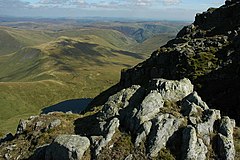 View from Aran Fawddwy | |
|---|---|

| |
| Flag | |
| Tra môr, tra Meirion (While the sea lasts, so shall Merioneth) | |
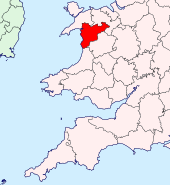
| |
| [Interactive map] | |
| Area: | 676 square miles |
| Population: | 37,874 |
| County town: | Harlech or Bala |
| County flower: | Welsh poppy [1] |
The County of Merioneth is a triangular shire reaching from the coast on Cardigan Bay high into the mountains.
Merionethshire is one of the strongest Welsh-speaking parts of Wales. With a total area of 780 square miles and a population of 37,874, Merioneth is one of the more sparsely-populated counties in Great Britain.
The county is a shire of mountain and coast; the coastland is perhaps best known to visitors, but the heartland in the mountains is a place of rough beauty. Merionethshire appears split in two by the mountains; Bala in the east is far from the Victorian towns of the coast, but a Roman road ran over the mountain from Bala to Dolgellau, a route now traced through the valley by the A494.
The main industries of Merionethshire today are agriculture, forestry and tourism.
The lie of the land
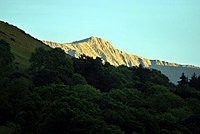
Merionethshire is a county on the sea coast and of the mountains. It lies between Caernarfonshire and Denbighshire both to the north and Montgomeryshire to the south. Much of Merionethshire is in the mountains reaching in from Snowdonia, a land of rough mountainous terrain. The county's two rival county towns lie either side of the Snowdonia massif; Bala in the east at the head of Lake Bala, and Harlech on the coast in the west.
To the west the shire is washed by the gulf of the Irish Sea known as Cardigan Bay. The county's coast runs from the great inlet of the River Glaslyn estuary, south to the estuary of the River Dovey. Between the two is a third deep-cut sealoch, the Mawddach opening into Barmouth Bay.
The shire is bounded to the north by Caernarfonshire, to the east by Denbighshire, to the south by Montgomeryshire and Cardiganshire.
One of the more sparsely populated counties in the United Kingdom, Merioneth remains one of the strongest Welsh-speaking parts of Wales. The coastline consists alternately of cliffs and stretches of sand and the area generally is the most mountainous in Wales. A large part of the Snowdonia National Park lies within Merionethshire. The greatest heights are:
- Aran Fawddwy (2,970 feet)
- Cadair Idris (2,929 feet).
The chief rivers of the county are the Dwyryd, the Mawddach and the Dovey. Waterfalls and small lakes are numerous, the largest lake being Bala Lake which is four miles long and a mile broad.
History
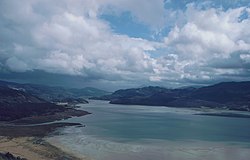
Merionethshire's name, in legend and possibly in fact, is from Meirion, a grandson of the mighty chief Cunedda who ruled this corner of Britain in late Roman or sub-Roman times.
The county was formed in 1284 under the terms of the Statute of Rhuddlan from the Cantrefi of:
- Meirionnydd
- Dunoding (but only the larger Ardudwy commote)
- Penllyn
- The Lordship of Dinmael
Harlech castle was built by King Edward I as part of his "Iron Ring" around the Forest of Snowdon and stands proud, if abandoned on the hill. Between 1404 and 1409 Owain Glyndŵr held the castle and ruled his territory from here. The county played its part too in the Wars of the Roses; Harlech again endured a seven-year siege of the castle between 1461 and 1468, when Dafydd ap Ieuan staunchly resisted the Yorkists; an action memorialised in the famous song "Men of Harlech".
Merioneth was an important part of the Welsh slate industry in the nineteenth and twentieth centuries, with major quarrying centres at Blaenau Ffestiniog in the north of the county and Corris in the south. The railways came in the nineteenth century and brought work, workers and new town-building. The trains also brought holiday-makers, who made Barmouth a popular seaside resort and Bala a place for those seeking the vigorous, fresh mountain air.
Some of the railways remain. The slate-bearing line from Blaenau Ffestiniog is now a popular tourist attraction, as is the half-mile bridge across the Mawddach to Barmouth. Bala is cut off from the railway network, but a narrow-gauge line runs along the lake.
Main Towns
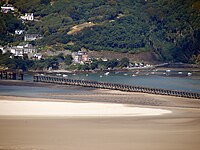
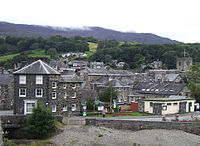
Towns and villages
The main towns of Merioneth are:
Parishes
- Aberdovey
- Bala
- Arthog
- Barmouth
- Betws Gwerfil Goch
- Brithdir and Llanfachreth
- Bryn-Crug
- Corris
- Corwen
- Cynwyd
- Dolgellau
- Dyffryn Ardudwy
- Ffestiniog
- Ganllwyd
- Gwyddelwern
- Harlech
- Llanbedr
- Llandderfel
- Llandrillo
- Llanegryn
- Llanelltyd
- Llanfair
- Llanfihangel-y-Pennant
- Llanfrothen
- Llangelynin
- Llangywer
- Llanuwchllyn
- Llanycil
- Maentwrog
- Mawddwy
- Pennal
- Penrhyndeudraeth
- Talsarnau
- Trawsfynydd
- Tywyn
Things to see in Merionethshire

| Key | |
| Cathedral/Abbey/Priory | |
| Accessible open space | |
| Amusement/Theme Park | |
| Castle | |
| Country Park | |
| Cadw | |
| Forestry Commission | |
| Heritage railway | |
| Historic House | |
| Museum (free/not free) | |
| National Trust | |
| Zoo | |
- Lake Bala, Bala
- Cadair Idris mountain SH711130
 Castell y Bere SH667085
Castell y Bere SH667085 Cymer Abbey SH721195
Cymer Abbey SH721195 Harlech Castle SH5731
Harlech Castle SH5731- Portmeirion Italianate village SH589372
- Rhug Chapel SJ063439
- Tomen-y-mur Roman Fort SH7038
 Ffestiniog Railway SH6946
Ffestiniog Railway SH6946 Corris Railway SH7507
Corris Railway SH7507 Talyllyn Railway SH5800
Talyllyn Railway SH5800 Fairbourne Railway SH6112
Fairbourne Railway SH6112
See also
References
| Counties of the United Kingdom |
|---|
|
Aberdeen • Anglesey • Angus • Antrim • Argyll • Armagh • Ayr • Banff • Bedford • Berks • Berwick • Brecknock • Buckingham • Bute • Caernarfon • Caithness • Cambridge • Cardigan • Carmarthen • Chester • Clackmannan • Cornwall • Cromarty • Cumberland • Denbigh • Derby • Devon • Dorset • Down • Dumfries • Dunbarton • Durham • East Lothian • Essex • Fermanagh • Fife • Flint • Glamorgan • Gloucester • Hants • Hereford • Hertford • Huntingdon • Inverness • Kent • Kincardine • Kinross • Kirkcudbright • Lanark • Lancaster • Leicester • Lincoln • Londonderry • Merioneth • Middlesex • Midlothian • Monmouth • Montgomery • Moray • Nairn • Norfolk • Northampton • Northumberland • Nottingham • Orkney • Oxford • Peebles • Pembroke • Perth • Radnor • Renfrew • Ross • Roxburgh • Rutland • Selkirk • Shetland • Salop • Somerset • Stafford • Stirling • Suffolk • Surrey • Sussex • Sutherland • Tyrone • Warwick • West Lothian • Westmorland • Wigtown • Wilts • Worcester • York |